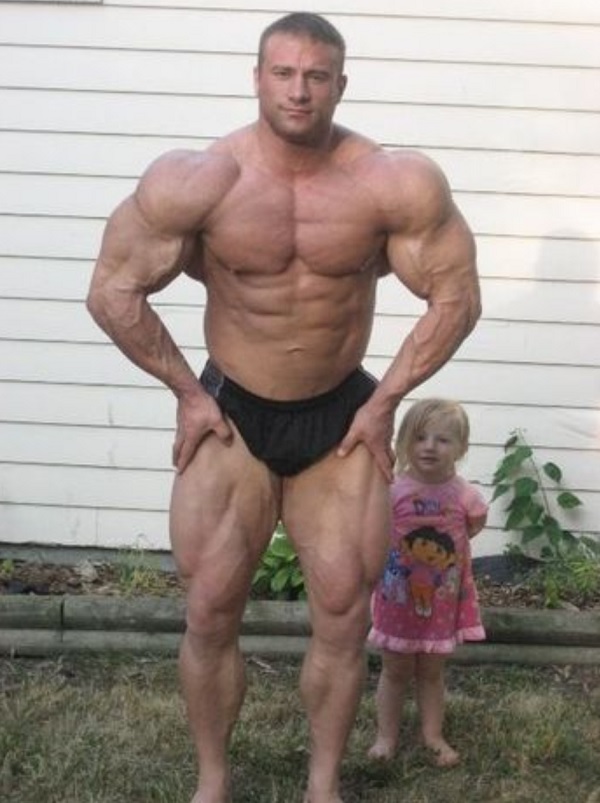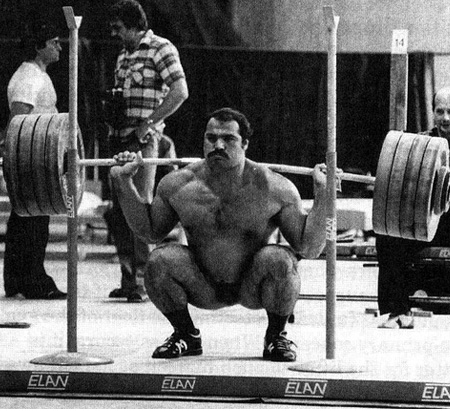Yep, it’s an age-old question – but one that we can learn a lot from.
If you listen to the bros (whether in the gym or online), you’ll probably think that you have to squat if you want big legs, or if you want to be “hardcore.” But the truth is, there’s nothing magical about squats. And, if you’re not performing them properly for your goals, chances are that they’ll do more harm than good.
I was discussing this very topic recently with my coach, Justin Harris. If you don’t know Justin, he’s the guy that got Dave Tate shredded, and he practices what he preaches. Justin won the Junior USA bodybuilding show in 2006. He’s also squatted 876 in competition, and 500 for 16(!) reps in the gym.
Editor’s note: This article is an op-ed. The views expressed herein and in the video are the author’s and don’t necessarily reflect the views of BarBend. Claims, assertions, opinions, and quotes have been sourced exclusively by the author.
Yet Justin doesn’t think squats are the best leg builder. In fact, he says, they’re pretty overrated:
“[Squats are the] most overrated exercise for quad size ever. 90% of people who squat as a primary movement have [smaller] legs than they should. It’s a fun movement, but very few people are built to build max quad size from squatting. They’re a movement worth keeping in, but move them towards the end of a leg workout, make sure your form is quad focused, and try to make a lighter weight harder rather than use a heavier weight – going heavier almost always means taking the emphasis off of the quads to spread it out over adductors, glutes, hams, etc., to improve leverages.”
That last point is key, and I’d like to expand on it.
Squatting Technique and Leg Size
During our discussion, Justin and I started talking about safety bar squats, a movement I’m using as a primary tool in my off-season to improve both my leg size and squatting strength. I am one of the lucky few who can build big legs from squats alone, and I’m pretty good at moving some heavy weight, too – although not quite as much as Justin.
https://www.instagram.com/p/Bk3m-qQHJhg/
And my safety bar squats aren’t bad, either.
https://www.instagram.com/p/BNuvNQTghWu/
Justin mentioned that he’s relatively weak at safety bar squats and suggested that that weakness must be indicative of some sort of muscular imbalance. In my opinion, though, it’s more a matter of technique.
When you watch Justin squat with a straight bar, he stays in a very balanced position, using a fairly wide stance and distributing the load equally among his quads, hamstrings, and glutes. In contrast, I use a very narrow stance, push my knees way forward, and rely almost entirely on my quads and lower back. Neither of these is right or wrong, but when framed in that light, it’s pretty obvious why I would get more quad development from competition-style squats.
Now consider the safety bar, which does two things:
- Allows you to save strain on your shoulders (holding onto the handles allow you to keep the shoulders in a more neutral position, rather than one that’s somewhat internally rotated and requires a good deal of flexibility in the pecs and biceps).
- Forces you into a more upright position (the pad on top of the bar functions similarly to a Manta Ray, shifting your center of gravity even more forward than a traditional high-bar squat would).
It’s the second point we’re concerned with here. A more upright squatting position shifts emphasis to the quads, so many would assume that if you’re relatively weak using the safety bar, that’s because your quads are weak.
Justin’s quads aren’t weak. There is no way to squat 875 for a single and 500 for 16 with weak quads. Especially not when they look like this:

I think we have to look a little deeper to get to the real answer here, and in my opinion, it concerns technique. Remember what I wrote earlier about how I push my knees forward a lot when I squat? Well, a high-bar squatting position actually requires that.
It’s why you see so many Olympic weightlifters in positions like this:

So, I’m used to squatting using mechanics similar to that of a high-bar squat – even though I squat with a low-bar position. Justin isn’t. That is likely the major factor behind Justin’s “weak” safety bar squats: lack of practice. Remember, strength is a skill, and even if Justin is used to using a lot of forward knee displacement on movements like hack squats or lunges, that won’t necessary transfer over to the safety bar.
There are some other possible compounding factors as well. Justin’s back is massive, which likely makes it more difficult for him to find a comfortable position with the safety bar pads (they’re narrow even for me, and I’m half a foot shorter and 50 pounds lighter than him). Or he may simply lack the ankle mobility necessary to achieve the required amount of forward knee displacement. Ultimately, though, I believe it’s the lack of practice more than anything that makes the safety bar seem like a weak movement.
Takeaways
So, how does this apply to you and your training? A few ways:
- Remember: you always have to find what works for you. If you are weak at a particular movement, don’t necessarily assume that it’s due to a lack of strength. Consider ingrained movement patterns, leverages, and similar underlying causes.
- On the other hand, don’t blindly assume that because you’re improving at a particular movement, you’re actually getting stronger. That improvement might be attributed simply to practice rather than muscular adaptation (this is a commonly-cited pitfall of the exercise rotation used in Westside and Doggcrapp methods of training).
- Finally, remember that there’s no one magic exercise. Squats, safety bar squats, lunges, whatever – if they help you achieve your goals, they’re useful tools. If they don’t – then don’t waste your time on them, especially not to prove that you’re “hardcore,” or anything along those lines.
What movement do you suck at? Share it in the comments below, or tag a friend who needs to step their squat game up!
Feature image from @phdeadlift Instagram page.